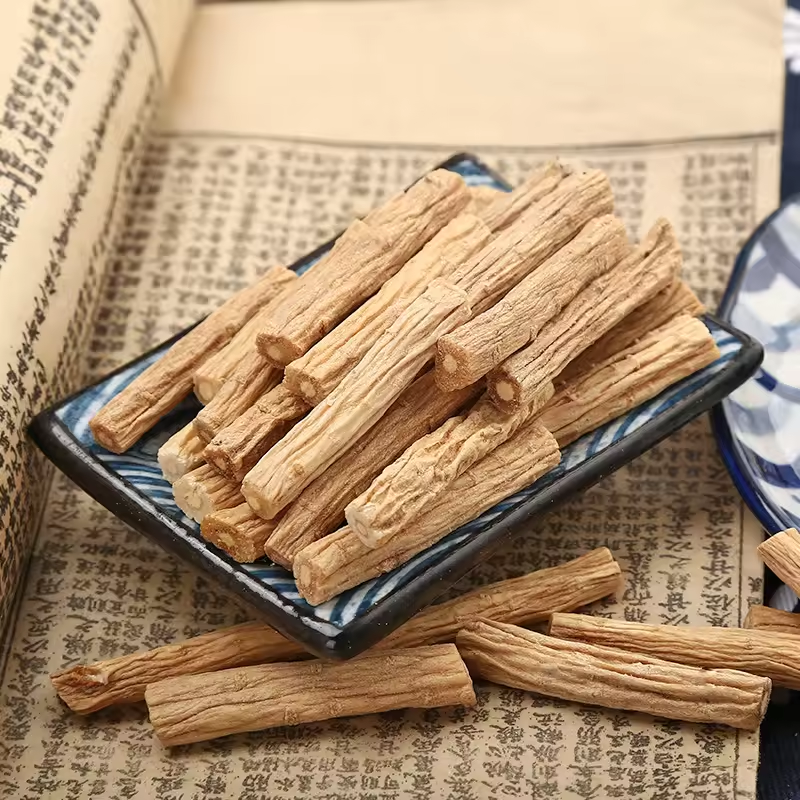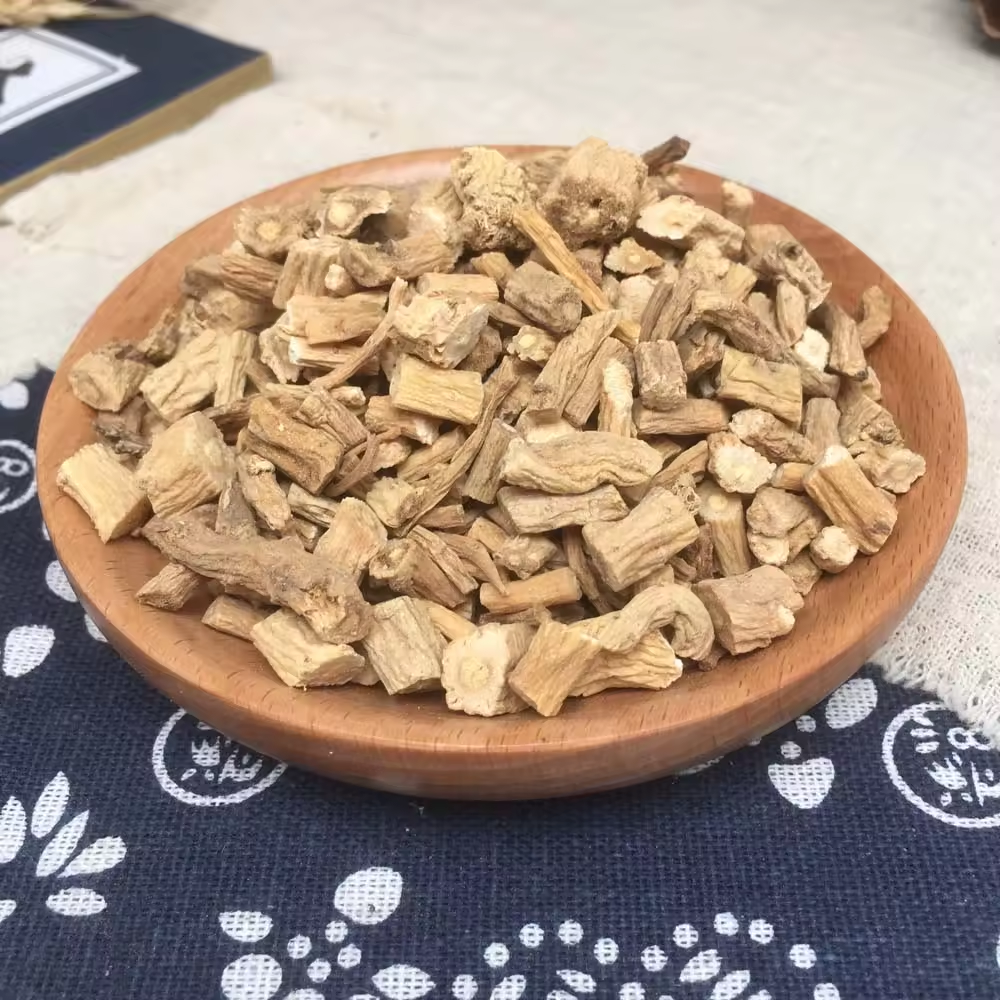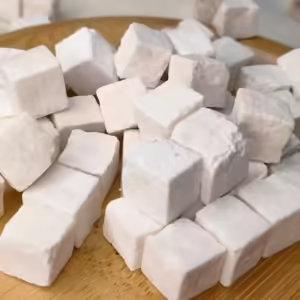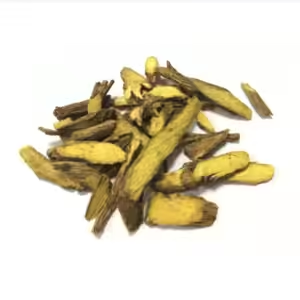Codonopsis is a Qi-tonifying medicine, the dried root of Codonopsis pilosula, Codonopsis pilosula, or Codonopsis pilosula of the Campanulaceae family.
Codonopsis pilosula is sweet and flat in nature. It enters the spleen and lung meridians.
Codonopsis pilosula is sweet and flat, not dry or greasy, and enters the spleen and lung meridians. The Qi-tonifying power is inferior to that of ginseng, and is mostly used for mild symptoms of spleen and lung Qi deficiency. It also produces body fluid and nourishes blood, and can treat symptoms such as body fluid deficiency and blood deficiency.
This product mainly contains codonoside, glucose, inulin, polysaccharides, codonopsis alkaloids, volatile oils, flavonoids, phytosterols, trace elements and other ingredients.
Where is the main medicinal part of Codonopsis pilosula?
The medicinal part of Codonopsis pilosula:
The dried root of Codonopsis pilosula (Franch.) Nannf., Codonopsis pilosula Nannf.var.modesta (Nannf.) L.T.Shen, or Codonopsis tangshenOliv. of the Campanulaceae family. The shape characteristics of the medicinal parts of Codonopsis:
Codonopsis is long cylindrical, slightly curved, 10~35cm long, 0.4~2cm in diameter.
The surface is grayish yellow, yellow-brown to grayish brown, and there are many warty stem scars and buds on the root head. The top of each stem scar is concave and dot-shaped: there are dense annular horizontal stripes under the root head, which gradually become sparse downwards, and some reach half of the total length. The cultivated products have few or no annular horizontal stripes: the whole body has longitudinal wrinkles and scattered long lenticel-like protrusions, and there are often dark brown colloids at the broken roots.
The texture is slightly soft or slightly hard and slightly tough, the cross section is slightly flat, with cracks or radial textures, the cortex is light brown to yellow-brown, and the wood is light yellow to yellow. It has a special aroma and tastes slightly sweet.
Suhua Codonopsis (Western Codonopsis) is 10~35cm long and 0.5~2.5cm in diameter. The surface is yellowish white to grayish yellow, and the dense annular horizontal stripes under the root head often reach more than half of the total length. There are many cracks in the cross section, and the skin is grayish white to light brown. Sichuan Codonopsis is 10~45cm long and 0.5~2cm in diameter. The surface is grayish yellow to yellow-brown, with obvious irregular longitudinal grooves. The texture is soft and firm, with fewer cracks in the cross section and yellowish white skin.
How is Codonopsis recorded in ancient books?
“Ben Jing Feng Yuan”: “Although Shangdang ginseng does not have the effect of sweet and warm tonic, it has the power of sweet and flat tonic, and is not like Adenophora, which is cold and specializes in draining lung qi.
“Bencao Congxin”: “Tonic, Qi, spleen and stomach, eliminate thirst. The middle qi is slightly weak, and it is used to regulate and replenish, which is very safe.
“Bencao Gangmu Shiyi”: “Treat lung deficiency and benefit lung qi.
“Bencao Zhengyi”: “Dangshen can nourish the spleen and stomach, moisten the lungs and produce fluid, and strengthen the middle qi, which is not far from ginseng. What is particularly valuable is that it strengthens the spleen and lungs without being dry, nourishes the stomach yin without being damp, moistens the lungs without being cold, nourishes the blood without being greasy, invigorates the clear yang, and vibrates the middle qi without being rigid and dry.
प्रभाव र कार्यहरू
Dangshen has the functions of strengthening the spleen and lungs, nourishing blood and producing body fluid.
What are the main effects and clinical applications of Codonopsis?
Dangshen is used for spleen and lung qi deficiency, fatigue due to poor appetite, cough and weak asthma, insufficient qi and blood, sallow complexion, palpitations and shortness of breath, thirst due to loss of body fluid, and internal heat and thirst.
Spleen and lung qi deficiency syndrome:
· Treat spleen qi deficiency with physical weakness and fatigue, poor appetite and loose stools, etc., and often use it together with Atractylodes macrocephala and Poria cocos;
Treat lung qi deficiency with shortness of breath, weak voice, cough and weak asthma, etc., and can be used together with Astragalus membranaceus and Schisandra chinensis. .
Qi and blood deficiency and qi and fluid deficiency syndrome:
Treat qi and blood deficiency with sallow complexion, dizziness, palpitations, limb fatigue, etc., often used with Astragalus, Angelica, Rehmannia glutinosa, etc.; treat qi and fluid deficiency with thirst and internal heat and thirst, often used with Ophiopogon japonicus, Schisandra chinensis, etc.
What other effects does Codonopsis pilosula have?
Fatigue, cough and fatigue caused by lung and spleen deficiency:
Codonopsis pilosula 500g (soft and sweet, sliced), Adenophora adenophora 250g (sliced), Longan pulp 120g. Boil in water to make a concentrated juice, drip into beads, and store in porcelain. Use 1 wine glass each time, empty boiling water to drink, or pour into the decoction. Waist pain, shortness of breath, palpitations, insomnia, spontaneous sweating caused by qi and blood deficiency:
Codonopsis pilosula, Angelica, Chinese yam 10g each, 500g pork loin, soy sauce, vinegar, ginger, garlic, sesame oil appropriate amount,
Pork loin cut to remove fascia and smelly glands, wash. Put the washed angelica, codonopsis, yam and pork kidney in the pot, add appropriate amount of water, and stew until the pork kidney is cooked. Take out the pork kidney, let it cool, cut it into thin slices, put it on a flat plate, add soy sauce, vinegar, shredded ginger, minced garlic, sesame oil and other seasonings and it can be eaten. Eat it with meals frequently.
Fatigue and sleepiness, edema of the head and face, edema of the limbs, poor appetite and loose stools:
3g codonopsis, 3g astragalus, 200g chicken breast, 1kg winter melon, salt, rice wine and other appropriate amounts.
Wash codonopsis and astragalus, cut chicken into strips, peel the winter melon, and cut it into pieces horizontally. Put the winter melon in a soup bowl, put the shredded chicken, codonopsis, astragalus, salt, rice wine and monosodium glutamate on the winter melon, and add appropriate amount of water. Put the winter melon bowl in a steamer and steam it until cooked. Eat it with meals frequently.
What are the compound preparations containing codonopsis?
Buzhong Yiqi Pills:
Buzhong Yiqi, Shengyang Lifts the Sunken. It is used for diarrhea, rectal prolapse, and uterine prolapse caused by spleen and stomach weakness and sinking of middle qi. Symptoms include fatigue, poor appetite, abdominal distension, loose stools, chronic diarrhea, anal prolapse or rectal prolapse, and uterine prolapse.
Lizhong Pills:
Warms the middle and dispels cold, and strengthens the stomach. It is used for spleen and stomach deficiency and cold, vomiting and diarrhea, chest fullness and abdominal pain, and indigestion. Shensu Pills:
Replenishes qi and relieves the symptoms, dispels wind and cold, and relieves phlegm and cough. It is used for physical weakness and cold caused by wind and cold. Symptoms include aversion to cold and fever, headache and nasal congestion, cough and sputum, chest tightness and vomiting, fatigue and shortness of breath.
Bazhen Pills:
Replenishes qi and blood. It is used for deficiency of both qi and blood, sallow complexion, loss of appetite, fatigue in the limbs, and menorrhagia. Jianpi Pills:
Replenishes spleen and appetizers. It is used for spleen and stomach weakness, abdominal distension, poor appetite and loose stools.
Bupi Yichang Pills:
Replenishes qi and nourishes blood, warms yang and promotes qi, and astringes the intestines to stop diarrhea. It is used for diarrhea caused by spleen deficiency and qi stagnation, with symptoms of abdominal distension and pain, intestinal rumbling and diarrhea, and mucus and blood in the stool; chronic colitis, ulcerative colitis, and allergic colitis with the above symptoms.
Shenqi oral liquid:
Replenishing qi and strengthening the body. It is used for weak body and qi deficiency, and weakness in the limbs.
Modern research progress on Codonopsis pilosula
This product has multiple pharmacological effects such as enhancing the body’s adaptability, enhancing immune function, delaying aging, anti-ulcer, sedation, analgesia, promoting sleep, improving learning and memory functions, increasing red blood cells and hemoglobin, antibacterial, anti-inflammatory, and auxiliary anti-tumor.
प्रयोग विधि
Codonopsis pilosula has the function of strengthening the spleen and lungs, nourishing blood and producing body fluid. It can be taken with more decoction, or boiled in water, porridge or soup. But no matter which method is used, it needs to be taken according to the doctor’s instructions.
How to use Codonopsis pilosula correctly?
When Codonopsis pilosula is taken orally, the usual dosage is 9~30g.
It is suitable to be used raw for producing body fluid and nourishing blood; it is suitable to be roasted for tonifying the spleen and lungs. Different preparation methods have different effects, but the method of use is the same. Please follow the doctor’s advice for specific use. Codonopsis is generally used in decoctions, decocted and taken, or made into powder or pills. However, the use of Chinese medicinal materials must be based on syndrome differentiation and treatment, and should be used under the guidance of professional Chinese medicine practitioners. It should not be used at will, and it should not be used at will, let alone listen to Chinese medicine prescriptions and advertisements.
In addition, Codonopsis can also be used for daily health care. The common methods of consumption are as follows
· Cook porridge (Shenling porridge): 10g each of Codonopsis, Poria, and ginger, and 100g of polished rice. First, boil the three herbs in water to extract the juice, then add rice and cook it into porridge. Salt can be added for seasoning. Codonopsis and Poria nourish the stomach, ginger warms the middle and strengthens the stomach, stops vomiting, and polished rice nourishes the spleen and nourishes the stomach. It is used for symptoms such as weak spleen and stomach, poor appetite and vomiting, and weight loss and fatigue.
Soup (Dongshen and Asparagus stewed with radish): prepare 20g each of Codonopsis and Asparagus, and 500g of white radish (cut into pieces). Put Codonopsis, Asparagus cochinchinensis and white radish into a casserole, add appropriate amount of water, boil over high heat and simmer over low heat for 30 minutes. Eat 150g of radish once a day. It has the effect of nourishing the kidney and lungs and relieving cough and asthma.
Soaking wine: Codonopsis soaking in wine has the effect of strengthening the spleen and replenishing qi. It can also be used with other Chinese medicines to soak in wine.
Note: Codonopsis should not be taken for real heat syndrome.
How to prepare Codonopsis?
· Codonopsis: Take the original medicinal material, remove the reed head, wash, moisten, cut into thick slices, and dry. , Rice Codonopsis: Take rice and put it in a frying pot, heat it over medium heat until the rice smokes, pour in the raw Codonopsis slices, fry until the rice is old yellow, take it out, sieve out the rice, and let it cool. For every 100kg of Codonopsis, use 20kg of rice.
Honey Codonopsis: Take refined honey and dilute it with an appropriate amount of boiling water, add Codonopsis slices and mix well, simmer thoroughly, put it in a frying pot, heat it with a slow fire, stir-fry until it is yellow-brown, take it out when it is not sticky, and let it cool. For every 100kg of Codonopsis, use 20kg of refined honey.
What drugs should be used with Codonopsis at the same time?
यो Veratrum संग प्रयोग गर्नु हुँदैन।
The combined use of Chinese medicine and Chinese and Western medicine requires syndrome differentiation and clinical individualized treatment
औषधि निर्देशन
Although Codonopsis is flat in nature, it is sweet and nourishing, so it is not suitable for real heat syndrome.
What are the precautions when using Codonopsis?
Codonopsis should not be used with Veratrum.
It is forbidden for those with qi stagnation and anger; it is taboo for those with fullness and fire in the middle
Pregnant and breastfeeding women: If you are pregnant, planning to be pregnant or are breastfeeding, please inform your doctor in time and consult whether Chinese medicine can be used for treatment.
बालबालिका: बालबालिकाको औषधि डाक्टरको निर्देशन र वयस्क पर्यवेक्षणमा गर्नुपर्छ।
Please keep the medicinal materials properly and do not give your own medicinal materials to others. .
How to identify and use Codonopsis?
Ginseng and Codonopsis
Ginseng and Codonopsis have the functions of tonifying spleen qi, tonifying lung qi, replenishing qi and generating body fluid, replenishing qi and generating blood, and strengthening the body and expelling evil. They can be used for spleen qi deficiency, lung qi deficiency, thirst caused by body fluid, thirst, blood deficiency, and qi deficiency and evil excess.
Codonopsis is sweet and mild in nature, with a mild effect and weak medicinal power. In ancient prescriptions, patients with mild and chronic diseases can use Codonopsis to replace ginseng in large doses, while ginseng is still suitable for acute and severe diseases.
However, Codonopsis does not have the function of ginseng to replenish qi and rescue. For any symptoms of vital energy collapse, ginseng should be used to rescue collapse, and Codonopsis cannot be used as a substitute. In addition, ginseng is also good at replenishing qi and yang, calming the mind and increasing intelligence, while Codonopsis has a similar effect that is not obvious, but it also has the function of replenishing blood.
बिरामीहरू द्वारा प्रायः सोधिने प्रश्नहरू
What are the effects and functions of drinking Codonopsis and Astragalus soaked in water?
Drinking Codonopsis and Astragalus soaked in water together has the effects of replenishing the middle qi, strengthening the spleen and benefiting the lungs. At the same time, it can restrain sweating and consolidate the body, support sores and promote tissue regeneration, and promote diuresis and reduce swelling. In clinical practice, Codonopsis and Astragalus are often used together, which has a complementary effect. The effect of boiling water together is more reflected in the treatment of patients with qi deficiency and weak blood, that is, patients with weak bodies. It is also good to boil water or stew chicken and duck with Codonopsis and Astragalus.
The use of both drugs together has a very good effect on improving the body’s middle qi, treating patients who have just recovered from a serious illness and patients who have undergone major surgery. It can make them full of energy, and will not produce too much greasiness, and will not produce too much dampness. For some patients, especially the elderly, it is very beneficial to control the disease.
What are the benefits of eating Codonopsis for women?
Female friends can replenish qi and blood, nourish blood and calm the mind by eating Codonopsis.
Female friends who eat Codonopsis for a long time can help the body lower blood sugar and blood pressure, protect the liver, enhance the body’s immunity, and improve the body’s resistance to disease.
Can Codonopsis pilosula strengthen the yang and tonify the kidney?
Codonopsis pilosula has a good health care effect, but its main function is to invigorate the qi, calm the mind and soothe the nerves. It is used clinically to strengthen the spleen and lungs, but does not have the effect of strengthening the kidney and strengthening the yang, and does not have a good effect on improving the kidney deficiency symptoms of patients.
Codonopsis pilosula - dang शेन
१TP१T १TP२Tमूल्य दायरा: १TP१T देखि १TP२T सम्म
+ नि: शुल्क ढुवानीCodonopsis pilosula (attached: Codonopsis pilosula)
[Family, Genus and Medicinal Parts] This product is the root of Codonopsis pilosula or Codonopsis pilosula, a plant in the Campanulaceae family.
[Nature, flavor and meridians] Sweet, flat. Enters the spleen and lung meridians.
[Efficacy] Buzhong and Qi.
[Clinical Application] It is used for symptoms such as insufficient qi, fatigue, shortness of breath, spleen deficiency, lack of food, edema, chronic diarrhea and prolapse.
This product is a qi-tonifying medicine commonly used in clinical practice. Its function is to nourish the spleen and lungs, and its effect is similar to that of ginseng but less effective. It is suitable for various diseases of qi deficiency. It is often used clinically in combination with Astragalus, Atractylodes, yam, etc.; such as blood For symptoms of deficiency of both Qi and blood caused by deficiency, chlorosis and chronic bleeding disorders, this product can also be used with blood-tonifying medicines such as Rehmannia glutinosa and Angelica sinensis.
| वजन | 1 किलो, 10 केजी, 100 केजी |
|---|


















समीक्षाहरू
अहिलेसम्म कुनै समीक्षाहरू छैनन्।